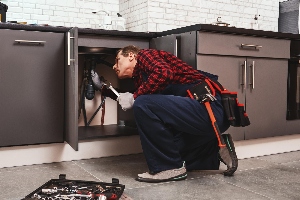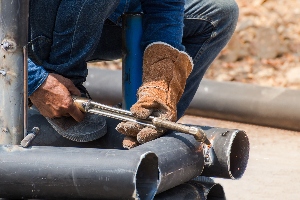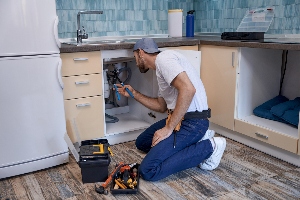Preventative water heater maintenance can extend your unit's life by up to 10-12 years for tank models and 20 years for tankless ones.
This means less money spent on repairs and replacements. Plus, a well-maintained water heater works more efficiently, which can lower your energy bills.
We'll guide you through some easy steps to keep your water heater in perfect shape.
From flushing out sediment to checking the anode rod, these tasks are doable for most homeowners if they have the correct tools.
In this guide, you’ll learn how to inspect, clean, and maintain your water heater, along with safety checks, expert recommendations, and when to call a professional.
Here's what you need to know:
- Water heater inspection and routine maintenance guide
- Preventative maintenance steps to extend water heater life
- Advanced water heater maintenance: Efficiency, minerals, and upgrades
- When to call a professional
These steps are simple but essential for keeping your water heater in peak condition year-round.
Water heater inspection and routine maintenance guide
Regular checks keep your water heater running smoothly and safely. We'll cover key steps to inspect and maintain your unit, from visual checks to testing important components.
How to visually inspect your water heater for damage or hazards
Begin with a thorough water heater inspection, checking for rust, dents, or loose parts. Look at pipes and connections for signs of wear, and ensure the area around the heater is clear of items that could catch fire. Check that vents are not blocked as this helps prevent carbon monoxide buildup in gas heaters. Also, look at the burner flame in gas heaters - it should be blue, and a yellow flame means it needs cleaning.
Keep an eye on the temperature setting which should be at 120°F (49°C) for safety and energy savings. Higher temperatures can cause burns and waste energy, while lower temperatures may not kill harmful bacteria.
How to check your water heater for leaks
Check for leaks regularly as even small drips can lead to significant water damage and other issues. Look at the base of the tank for water puddles, check all pipe connections, and inspect valves for moisture.
Water stains on walls or floors around the heater can also point to hidden leaks.
Feel around fittings and seams for wetness using a dry cloth to wipe areas you can't see well. If you find leaks, mark their location. Small leaks might just need tightening but bigger leaks may require part replacement or professional help.
How to test a water heater pressure relief valve
This valve is a key safety feature and should be tested regularly. First, find the valve on the side or top of the tank and put a bucket under the discharge pipe. Lift the valve's lever briefly. You should hear a rush of air or see water flow. If nothing happens, the valve may be stuck.
This is dangerous and needs fixing right away. After testing, watch for leaks around the valve. If it keeps dripping, it may need replacement. Always be careful when testing - the water can be very hot.
How to inspect and replace a water heater anode rod
The anode rod fights rust inside your tank and should be checked every year or two. Turn off the power and water supply, drain some water from the tank, and unscrew the hex head on top of the heater to remove the rod.
Look at the rod closely and if it's less than 1/2 inch thick, coated in calcium, or there is exposed steel wire, it's time for a new one. A working rod is about 3/4 inch thick. Wrap the threads with Teflon tape when putting in a new rod as this helps prevent leaks.
Preventative maintenance steps to extend water heater life
Regular maintenance can add years to your water heater's life and these simple steps will keep your unit running efficiently and prevent costly repairs.
How often should you perform preventative water heater maintenance?
Routine maintenance is critical to maximizing your water heater’s performance and lifespan—but timing matters. Different components of your system require attention at varying intervals depending on usage, water quality, and heater type.
For most homes, flushing the tank once per year is recommended to remove sediment buildup, especially in areas with hard water. In regions with particularly mineral-heavy water, flushing every six months may be necessary to prevent scale from coating the tank’s bottom or elements.
The anode rod should be inspected every 1–2 years, and replaced if it’s heavily corroded or worn below half an inch in diameter. Delaying replacement can accelerate tank corrosion and lead to leaks.
You should also test the temperature and pressure (T&P) relief valve annually to ensure it opens and closes properly. This safety component helps release excess pressure from the tank and can prevent dangerous overheating or bursting.
Adjusting the thermostat for seasonal efficiency and setting vacation mode during long absences are also useful maintenance habits, but these can be done as needed rather than on a fixed schedule. Keeping a simple annual checklist can help ensure you don’t overlook any key steps.
How to flush your water heater tank to remove sediment
Drain and flush your water heater tank once a year to remove sediment that can reduce efficiency and cause damage.
To do this, turn off the power and water supply, connect a garden hose to the drain valve, and run it to a suitable drainage area. Open the valve and let the tank drain completely. Once empty, turn the water supply back on briefly to stir up any remaining sediment, and repeat this process until the water runs clear. After flushing, close the drain valve, refill the tank, and restore power.
Removing sediment from your water heater: Tools and tips
Sediment buildup can cause many problems in your water heater, such as reducing efficiency, clogging valves, and creating hot spots that damage the tank.
To remove sediment, use a long, thin brush to scrub the inside of the tank after draining to loosen stubborn deposits. For tougher buildup, you can add a de-scaling solution to the tank before flushing. Let it sit for an hour, then flush as normal.
Adjusting the temperature
Setting the right temperature saves energy and prevents scalding. We recommend 120°F (49°C) for most homes.
To adjust:
- Find the thermostat (usually behind a panel)
- Use a flathead screwdriver to turn the dial
- Wait a few hours, then check the water temperature
- Adjust as needed
How to set your water heater to vacation mode
When you're away for more than a few days you should set your water heater to vacation mode. This lowers the temperature to save energy while still preventing freezing.
For gas heaters, turn the thermostat to the "vacation" or "pilot" setting and for electric heaters, switch off the circuit breaker. Remember to turn it back on and let the tank heat up fully before using hot water when you return.
Advanced water heater maintenance: Efficiency, minerals, and upgrades
Proper water heater maintenance goes beyond basic upkeep. We'll explore ways to boost efficiency, handle mineral buildup, and know when expert help is needed.
Water heater energy-saving upgrades and tips
- Insulating the tank and pipes reduces heat loss.
- Setting the temperature to 120°F (49°C) saves energy while still providing hot water.
- Installing low-flow fixtures cuts hot water use.
- Upgrading to a newer, more efficient model can lower energy bills.
- Heat pump water heaters use less electricity than standard electric units.
- Tankless heaters only heat water on demand.
- Solar water heaters harness free energy from the sun.
How hard water affects your water heater, and how to fix it
Hard water contains high levels of minerals like calcium and magnesium and these can form limescale buildup in water heaters. Limescale coats heating elements, reducing efficiency and shortening lifespan.
We can combat hard water issues in a few ways:
- Install a water softener to remove minerals before they enter the heater
- Use vinegar flushes to dissolve existing scale
- Add a scale inhibitor to the tank
- Replace the anode rod more often
If you have a tankless heater, flush it with vinegar every 6-12 months to prevent scale buildup.
When to call a professional
Not every water heater issue can, or should, be handled on your own. Some problems signal underlying damage or safety risks that require a licensed plumber. Contact a professional if you notice:
- A complete loss of hot water
- Inconsistent water temperature
- Unusual noises such as popping or hissing
- Discolored or foul-smelling hot water
- Water pooling around the tank or visible corrosion
- A drop in hot water pressure
These symptoms often point to issues with the thermostat, heating elements, gas burner, or tank integrity, repairs that involve pressurized systems, high voltage, or gas connections.
A licensed technician has the tools and training to diagnose these problems accurately and perform safe, code-compliant repairs. DIY fixes on gas or electric water heaters can lead to injury or void your manufacturer’s warranty.
Even if your system seems fine, scheduling a yearly professional inspection is one of the best ways to prevent emergencies and keep your water heater running efficiently for years to come.
What’s included in a professional water heater inspection?
While many preventative tasks can be done by homeowners, a professional water heater inspection brings expert-level precision and can catch problems early, before they lead to expensive failures or safety issues.
During a typical inspection, a licensed plumber will first conduct a visual assessment, checking for signs of corrosion, leaks, rust, or improper venting. For gas units, they’ll verify that the burner flame is blue (not yellow, which indicates incomplete combustion) and check for any gas line leaks.
They’ll test the T&P relief valve and inspect the anode rod, recommending replacement if it’s no longer protecting the tank. If your unit has not been flushed in over a year, they may perform a full tank flush to remove sediment, which can improve heating efficiency and prevent damage.
Technicians also verify the thermostat settings and electrical connections or gas controls, ensuring everything is operating within safety parameters. In tankless systems, descaling the unit with a vinegar solution may also be included to prevent scale buildup in the heat exchanger.
Beyond the technical checks, a professional can advise whether your system is still efficient or nearing the end of its service life, helping you plan for upgrades or future repairs proactively.
According to the U.S. Department of Energy, traditional tank-style water heaters typically provide 10–15 years of service life, whereas tankless units, thanks to modular components, often operate for more than 20 years
Conclusion
Staying on top of preventative water heater maintenance helps you avoid major repairs, lower your energy bills, and extend the life of your system, whether it’s tank or tankless. Simple tasks like flushing the tank, checking the anode rod, and testing the pressure relief valve can make a big difference when done consistently.
If you’re unsure about what needs attention or want peace of mind, a professional inspection ensures your water heater is operating safely and efficiently.
For expert water heater maintenance in Greenville or Spartanburg, schedule a service with One Call Plumbing today. Get in touch to arrange an inspection of your water heater or to discuss an upgrade.












